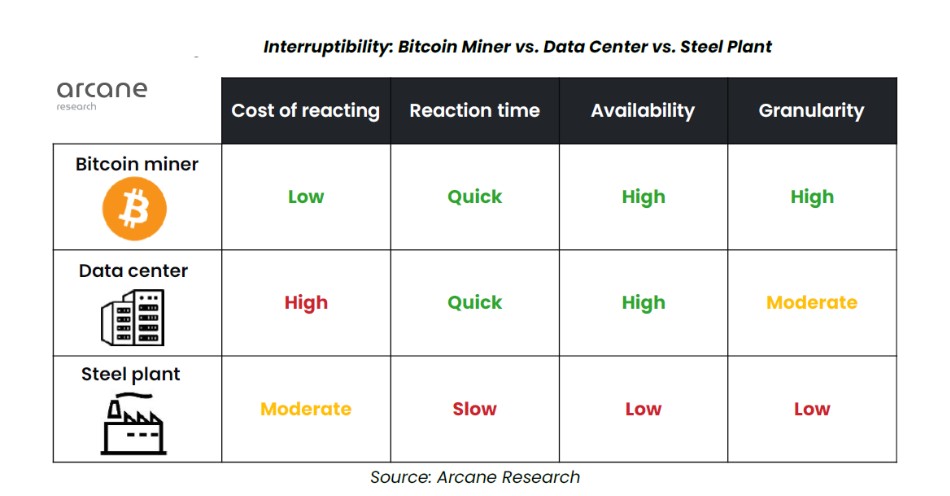A report from Arcane, published by CoinTelegraph, has indicated that While innovations in chipset manufacturing have helped reduce operational costs related to Bitcoin mining, a report has revealed the market’s potential to transform the energy industry.
Bitcoin Mining is said to be responsible for approximately 137 terawatt hours of energy consumption per year according to latest data from the Cambridge Bitcoin Electricity Consumption Index. According to Digiconomist, Ethereum produces more than 47 million tonnes of carbon dioxide emissions annually.
From their research, Arcane have stated that the flexibility that comes with BTC mining operations globally can be important in solving the real-world problems that the energy industry faces.
Those within the cryptocurrency mining industry know that the biggest concerns authorities and FUDers raise is the environmental impact of Bitcoin (and cryptocurrency) given its intense power and energy requirements. However, many of the harshest critics lack an understanding of both Bitcoin and energy systems.
The report points to four areas where BTC miners can affect energy systems in a desired way or improve the economics of energy production:
- Strengthening electricity grids with bitcoin mining
- Improving the economics of renewable energy with bitcoin mining
- Mitigating natural gas flaring with bitcoin mining
- Repurposing waste heat from bitcoin mining
Strengthening electricity grids with Bitcoin mining
The growth of wind and solar increases the need for flexible electricity demand because the supply is unstable and non-controllable. This flexible electricity demand is called demand response, and according to the IEA, we must increase its global capacity by a factor of 10 by 2030 to reach the Paris Agreement. Bitcoin mining is the best alternative for demand response due to its low cost of reacting, the possibility of responding immediately at the needed granularity, and the constant demand for electricity.

‘Bitcoin mining as a demand response is not just a possibility – it’s already happening. In the ERCOT system in Texas, Bitcoin miners provide demand response that strengthens a vulnerable wind and solar-powered electricity grid. Other industries also serve as demand response in Texas, but to date, the grid operator has only allowed bitcoin miners to participate in the most advanced demand response programs.’

Improving the economics of renewable energy with bitcoin mining
The growing share of wind and solar will lead to more wasted energy due to the variable nature of renewable energy production. Energy waste is an economic challenge that, if left unmitigated, can threaten the economics of renewable energy and thus limit its growth.
‘Bitcoin mining’s combination of location agnosticism, interruptibility, and modularity makes it the perfect purchaser of stranded renewable energy. Bitcoin miners can seek out areas with excess wind and solar and build a data center of the exact size needed to consume the surplus energy. Having a bitcoin mining load right next to remotely located wind and solar plants prevents energy waste and improves the economics of these projects.’
Mitigating natural gas flaring with bitcoin mining
Natural gas is produced as a byproduct of oil drilling. Harnessing this gas for consumption is not always economically viable for oil producers. In these cases, the oil producer ends up burning the gas on-site in a process called flaring.
In addition to being flexible to grid demands, Bitcoin mining can also aid in solving issues related to gas flaring, the process of burning natural gas associated with oil extraction.
Arcane in their research highlights that by leveraging the agnosticism, modularity, and portability of Bitcoin mining rigs, miners can setup operations next to oil wells, reasoning that “Per $1,000 investment, a Bitcoin mining system reduces emissions of 6.32 tons of CO2 equivalents per year, compared to 1.3 for wind and 0.98 for solar.”

Both economic and environmental forces drive the growth of oil field bitcoin mining. Gas flaring wastes an economic resource that the oil producer could have sold to generate income. By mining bitcoin, either by themselves or through a third party, the oil producer can earn some money off the gas instead of letting it go to waste.
Repurposing waste heat from Bitcoin mining
Bitcoin mining can further help the energy industry by repurposing its byproduct, heat, to heat up homes, industries, and other applications during the coming winter. It is important to note that heating accounts for roughly 40% of the world’s CO2 emissions.
Repurposing heat from Bitcoin mining offers various advantages, including operational subsidies and lower heating costs.

Repurposing heat from Bitcoin mining has three main advantages. First, the income from bitcoin mining subsidises the cost of the electricity used to produce the heat. In addition to lowering heating costs, using bitcoin mining for district heating can reduce carbon emissions if the machines are powered by renewable electricity. Thirdly, repurposing the heat from Bitcoin mining is essentially using the same energy twice. This offsets energy used by the Bitcoin mining industry since it outcompetes other miners that are not repurposing their heat.
The importance of the above research comes at a time when the Eurozone hit record inflation of 9.1% amid gas and energy crisis.

As Cointelegraph reported, energy prices made up the largest price push, up by an annual rate of 38.3% over the past month.
